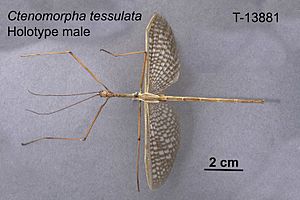Tessellated stick insect facts for kids
The Tessellated Stick Insect is a fascinating insect found in the Brisbane area of Australia. It is also known as the tessellated phasmid. These medium-sized insects are masters of disguise, blending in with their surroundings. Adult male tessellated stick insects can become very active during their mating season. Interestingly, this species can also reproduce without a male, a process called parthenogenesis.
Quick facts for kids Tessellated stick insect |
|
|---|---|
 |
|
| Male Ctenomorphodes tessulatus | |
| Scientific classification | |
| Kingdom: | |
| Phylum: | |
| Class: | |
| Order: | |
| Family: | |
| Genus: |
Ctenomorphodes
|
| Species: |
C. tessulatus
|
| Binomial name | |
| Ctenomorphodes tessulatus (Gray)
|
|
| Synonyms | |
|
|
What Does a Tessellated Stick Insect Look Like?
Tessellated stick insects usually have a brown-grey color. Female insects are larger, growing to about 150 millimeters (about 6 inches) long. Males are a bit smaller, reaching around 120 millimeters (about 4.7 inches) in length.
The name "tessellated" comes from the cool black and white patterns on their wings. These patterns look like a tessellation, which is a design made of repeating shapes. Female tessellated stick insects have short wings and cannot fly. However, the males have long wings and are able to fly.
Their eggs are quite tiny, only about 3 millimeters long. They are shiny black with a small white cap called a capitulum.
How Do Tessellated Stick Insects Behave?
Female tessellated stick insects have a unique way of laying their eggs. Like many other stick insects in Australia, they flick their eggs onto the ground. This action helps to attract ants. The ants then carry the eggs to their nests, where the eggs can hatch safely over time.
Raising Tessellated Stick Insects
Raising tessellated stick insects can be a fun and easy project. The young stick insects, called nymphs, will hatch best in certain conditions. They need to be in places like small cracks in rocks. They also hatch well on sand. Eggs will not hatch if the environment is too dry. Cold conditions can also help the eggs hatch, as long as they are not in a dry place and are in a crevice or on sand.
Female tessellated stick insects can reproduce without a male. This special ability is called parthenogenesis. It means that a single egg can start a whole new group of stick insects. All the stick insects born this way will be females. Sometimes, if there are too many stick insects, they might eat a lot of leaves from plants. This is called defoliation.
Caring for the nymphs is quick and simple. They do not need much cleaning. Once they become adults, if you want them to mate, it is also very easy.

